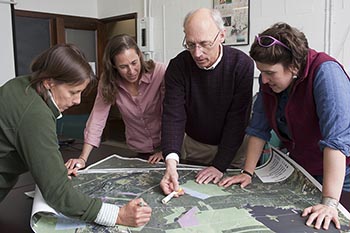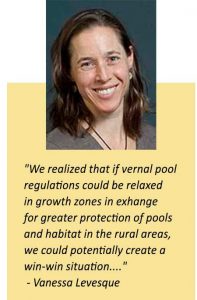Balancing Growth and Conservation to Benefit People and Wildlife
Like many towns in Maine, Topsham is contending with a common dilemma: how to grow in ways that don’t diminish the very things that people cherish about their community, like open space, wildlife and special landscapes.
 Orono Town Manager Evan Richert discusses vernal pool
Orono Town Manager Evan Richert discusses vernal pool
locations with SSI researchers Aram Calhoun, Vanessa
Levesque and Dawn Morgan.
“There is the constant tug between conservation and economic development,” says Rich Roedner, Topsham planning director. “How do you preserve or protect resources while still providing for local growth opportunities?”
That question is at the center of an SSI research project led by UMaine wetlands ecologist Aram Calhoun. Her team is using local vernal pool conservation as a model to examine how towns can plan future development in ways that benefit people and wildlife alike.
Vernal pools are central to healthy ecosystems—and to town planning and economic development. A state law passed in 2007 requires a permit for development activity within 250 feet of “significant” vernal pools. These pools provide critical breeding habitat for wood frogs and spotted and blue-spotted salamanders and help sustain other wildlife by serving as snack bars and rest stops in the forest.
The problem is that Maine’s vernal pool law needs to work better for human communities and for the intricate ecosystems it is supposed to protect. Although the law was passed in response to federal mandates and is based on years of research and broad consensus, its one-size-fits-all approach doesn’t give towns enough flexibility to guide development in the most cost-effective ways. In addition, the law doesn’t adequately protect habitat for pool-breeding amphibians, which spend most of their lives on land.
Calhoun’s team is seeking new solutions to these challenges in partnership with Topsham and Orono and local citizens, developers, nonprofits, and municipal, state and federal agencies. What they learn has potential to help towns around Maine and other states strike a balance between economic development and conservation of vernal pools and other key elements of a healthy landscape.
“Our team is working on conservation options that are practical and flexible,” Calhoun says. “You get effective land conservation when you address socioeconomic concerns together with ecological concerns.”
While team biologists are solving some of the mysteries of amphibian ecology (see sidebar), their colleagues in economics and other social sciences are tackling the human side of vernal pool conservation. They’re seeking ways to make the state regulations more adaptable to local needs, and they’ve discovered a promising approach.
“We realized that if vernal pool regulations could be relaxed in growth zones in exchange for greater protection of pools and associated habitat in the rural areas, we could potentially create a win-win situation,” says Vanessa Levesque, a PhD student on the team who is working on economic analyses of vernal pool conservation.
As this idea circulated, town officials, state and federal regulatory agencies, and developers all expressed enthusiasm. “The biologists liked the idea because they could get better protection of vernal pools, while regulators who do the permitting said it could streamline the process, which is also why the developers liked it,” says Levesque, who is working with team member Kathleen Bell, associate professor of economics at the University of Maine.
Calhoun’s team is now working with planners in Topsham and Orono and state and federal regulatory agencies to create model mechanisms. Regulatory agencies are considering an approach that would allow qualified towns to require developers to pay a fee rather than apply for additional permits to build near vernal pools in growth zones. This money would then be transferred to willing rural landowners to compensate them for protecting significant vernal pools on their land, most likely through a land trust or similar organization.
If this approach succeeds, it will give communities greater flexibility in charting their own future rather than having it ‘dictated’ by one-size-fits-all regulations. While the details are still being worked out in ongoing research and stakeholder meetings, this approach shows promise in helping communities address sustainability challenges.
This policy work builds on the Maine Vernal Pools Mapping Project, which Calhoun and other scientists created with Maine Audubon in 2001. Developed in response to requests from communities around the state, the project has so far trained citizen scientists and town officials in a dozen communities including Topsham and Orono on how to map and assess vernal pools for biological significance.
Such mapping can save communities and developers money and time by preventing expensive surprises, says Orono town planner Evan Richert. “Vernal pools can end up surprising people and stalling projects if not identified in advance,” Richert says. “The vernal pool project provided an economical way to gain much needed predictability for regulators and landowners alike.”
Reducing uncertainty and improving flexibility is key for planners like Richert and Rich Roedner. “The second phase of the project was of great interest to us,” says Roedner. “How to make vernal pool regulations more sensitive to local rules and needs, and how to adapt across-the-board environmental regulations to a more tailored set of regulations that address smart growth at the local level, not just at a regional or state level.”
The SSI team’s findings may help Maine communities meet often competing needs by striking a healthy balance. “Our work may begin to marry the concepts of conservation and economic development—making sustainable communities a concept that resonates with Maine municipalities,” Calhoun says.
See More…
